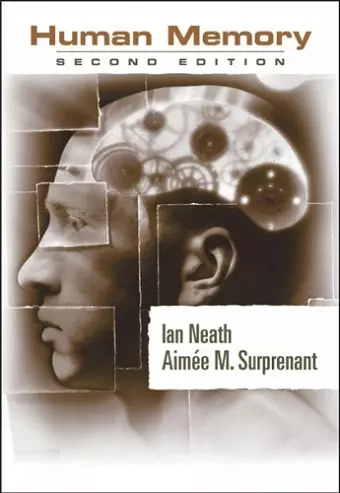Human Memory
Ian Neath author Aimee Surprenant author
Format:Paperback
Publisher:Cengage Learning, Inc
Published:3rd Dec '02
Currently unavailable, our supplier has not provided us a restock date

This book balances coverage of theory, research, and data in order to promote a more complete understanding of how human memory works. The book strikes a balance between historically significant findings and current research. Actual experiments, both paper and pencil and online demonstrations, are included to help students see the link between theory and data.
1. Introduction and Historical Overview. Introduction. Memory Metaphors. Memory Methodology. Memory Terminology. A Short History. Antiquity and the Middle Ages. The Beginning of Modern Psychology. ritish Empiricism and Continental Nativism. Scientific Psychology. Hermann Ebbinghaus. Experiment: The Forgetting Function. Research After Ebbinghaus. 2. Sensory Memory. Iconic Memory. Online Experiment: Partial Report Problems with Iconic Memory. Summary of Iconic Memory. Echoic Memory. Theories of Echoic Memory: PAS. Experiment: The stimulus suffix effect. Online Experiment: Suffix Effect. Other Theories of Echoic Memory. Summary of Iconic Memory. Odor Memory. Summary of Sensory Memory. 3. The Modal Model. Primary Memory. Broadbent's Model. Online Experiment: Absolute Identification. Brown-Peterson. Online Experiment: Brown Peterson. Waugh and Norman's Model. Atkinson and Shiffrin's Model. Online Experiment: Sternberg Memory Scanning. The Serial Position Curve and the Modal Model. Online Experiment: Serial Position. Problems with the Modal Model. Experiment: Recency Effects in Free Recall. Summary of the Modal Model. 4. Working Memory. Baddeley's Working Memory. The Phonological Loop. Experiment: The Syllable-Based Word Length Effect. The Episodic Buffer. Critique of Working Memory. Online Experiment: Memory Span. Working Memory as Activation. The Embedded Processes Model. Working Memory Capacity. Online Experiment: Operation Span. The Feature Model. Simulations Using the Feature Model. Critique of the Feature Model. Summary of Current Immediate Memory Theories. 5. Perspectives on Processing. Levels of Processing. Experiment: Levels of Processing. Transfer Appropriate Processing. Organization and Distinctiveness. Encoding Specificity Principle. Online Experiment: Encoding Specificity. Context and Memory. The Process Dissociation Framework. What is Encoded? Summary. 6. Forgetting. Consolidation Theory. Interference Theory. Decay versus Interference in Immediate Memory. Experiment: Buildup and Release from PI. Relative Distinctiveness. Online Experiment: Von Restorff Effect. Any Evidence for Decay? Forgetting as Discrimination. 7. Implicit Memory. Implicit Learning. Online Experiment: Implicit Learning. Experimental Dissociations.Experiment: Priming Word Fragment Completion. Theoretical Accounts of Implicit Memory. The Activation View. Multiple Memory Systems. Transfer Appropriate Processing. The Bias View.Comparing Bias, TAP, and the Multiple Systems Views. Summary. 8. Memory, the Brain, and Amnesia. The Neuron. The Brain. Methods of Investigation. Invasive Techniques. Noninvasive Techniques. Online Experiment: Brain Asymmetry. Experiment: Laterality of Language. Amnesia. HM: A Case Study. Theoretical Accounts of Amnesia. Summary. Alzheimer's Disease. Box: How can I tell the difference between Alzheimer's Disease and normal aging? Box: What are the treatments for Alzheimer's Disease and are they effective? Summary. Multiple Sclerosis. The Frontal Lobe. Where is Memory? 9. Recognition. Signal Detection Theory. Experiment: Recognition and Signal Detection Theory. Single Process Models. Generate-Recognize Models. Beyond Simple Generate-Recognize Models. Remember versus Know. Online Experiment: Remember Know. Recollection versus Familiarity. The Mirror Effect. Face Recognition. 10. Knowledge. Propositions and Concepts. Collins and Quillian's Hierarchical Model. The Feature Overlap Model. Experiment: Typicality Effects and Inference. Collins and Loftus' Spreading Activation Model. Knowing That You Don't Know. Priming. Online Experiment: Lexical Decision. Alternatives to Spreading Activation. Comparing Spreading Activation and Compound Cue Theory. How is Generic Memory Organized? Capacity and Acquisition. 11. Imagery. Analog versus Propositional Representations. The Dual-Task Method. Paivio's Dual-Coding Theory. Experiment: Dual Coding Theory. Mental Rotation. Online Experiment: Mental Rotation. Distinguishing Propositional from Analog Representation. Arguments Against Imagery. Imagery and Perception. Real versus Imagined Events. Eidetic Imagery. Other Forms of Imagery. Auditory Imagery. Odor Imagery. 12. Reconstructive Processes. Schemas. Specific Schemas. Malleability of Generic Memory. Eyewitness Memory. Flashbulb Memories. Hypnosis and Memory. The Cognitive Interview. Implanting Memories. Experiment: Memory for words not presented. Online Experiment: False Memory. Recovered Memories. Memory Illusions. 13. When. Data to be Accounted For. Models that Don't Work. Perturbation Theory. Experiment: Memory for Position. The Inference Model of Memory for When. Item Versus Order Information. Models of Serial Order. 14. Developmental Changes in Memory. 15. Mnemonics. Can I Improve My Memory? The Bad News. The Good News. Online Experiment: Link Word. Technical Mnemonics. Experiment: Imagery and Mnemonics. Exceptional Memories. 16. Supplement: Memory Models. SAM. Compound Cue Theory. Diffusion Model. MINERVA2. TODAM. Connectionist Models. Feature Model. 17. Appendix. Table A: Twenty-Four Nonsense Syllables (CVCs). Table B: Random Arrangements of the Digits 1-9. Table C: Ninety-six Two-Syllable Words. Table D: Eight Short and Eight Long Words. Table E: Twenty-Five Common Two-Syllable Nouns. Table F: Thirty Two Consonant Trigrams. Table G: Fifty-Six Category Names. Table H: Sixty Word Fragments. Table I: Eighty Concrete and Eighty Abstract Words.
ISBN: 9780534595623
Dimensions: 22mm x 185mm x 233mm
Weight: 748g
500 pages
2nd edition